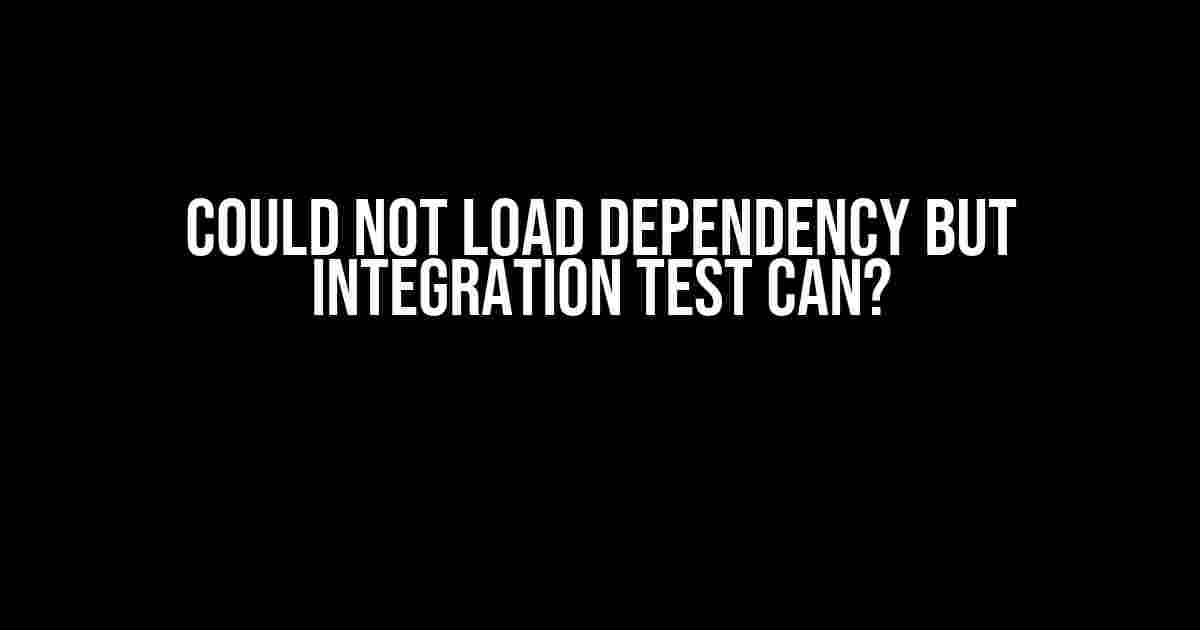If you’re reading this, chances are you’re stuck in a frustrating loop of error messages and failed builds. The infamous “Could not load dependency” error has taken over your screen, and you’re left wondering why your integration tests are working just fine. Fear not, dear developer, for we’re about to dive into the world of dependency loading and uncover the mystery behind this perplexing issue.
What is a Dependency, Anyway?
In the context of software development, a dependency refers to an external library or module that your project relies on to function correctly. Think of it as a recipe requiring a specific ingredient; without it, the dish won’t turn out right. In the world of coding, these ingredients are libraries like jQuery, React, or Express.js.
// A simple example of a dependency in a JavaScript project
import $ from 'jquery';
In this example, our project depends on the jQuery library to perform certain tasks. But what happens when our project can’t find this dependency?
The “Could not Load Dependency” Error
This error typically occurs when your project’s environment is unable to locate or load a required dependency. This can happen due to a variety of reasons, such as:
- Misspelled or incorrect import statements
- Missing or corrupted dependency files
- Dependency version conflicts
- Incorrectly configured package managers (e.g., npm or yarn)
- Network connectivity issues
But wait, you might be thinking, “My integration tests pass just fine! What’s going on?” Well, that’s where things get interesting…
Why Do Integration Tests Pass but My Project Fails?
Integration tests often run in a controlled environment, which can mask underlying issues. Here are some possible reasons why your integration tests might be passing despite the “Could not load dependency” error:
- Test EnvironmentConfiguration: Your test environment might be configured differently than your development environment. For instance, your test setup might be using a different package manager or version of the dependency.
- Mocked Dependencies: Integration tests often use mocking libraries to simulate dependencies. This can lead to a false sense of security, as the tests might not actually be loading the dependency in question.
- Test-Specific Configurations: Some tests might have specific configurations or overrides that allow them to bypass the dependency loading issue.
Now that we’ve covered the possible reasons behind this issue, let’s dive into solutions!
Solutions to the “Could not Load Dependency” Error
Don’t worry, we’ve got you covered! Here are some step-by-step solutions to help you resolve the “Could not load dependency” error:
1. Verify Import Statements
// Double-check that your import statements are correct
import $ from 'jquery/dist/jquery.min.js'; // Correct path
Make sure you’re importing the correct version of the dependency and that the path is accurate.
2. Check Dependency Installation
// Run the following command to verify dependency installation
npm ls jquery
Use your package manager to verify that the dependency is installed correctly. If not, try reinstalling the dependency or updating your package manager.
3. Resolve Version Conflicts
// Specify the correct version of the dependency in your package.json
"dependencies": {
"jquery": "^3.6.0"
}
If you’re using a package manager like npm, ensure that your package.json file specifies the correct version of the dependency. You can also try deleting the node_modules directory and running npm install again.
4. Configure Your Environment
// Set the correct environment variable for your dependency
process.env.JQUERY_PATH = './node_modules/jquery/dist/jquery.min.js';
In some cases, you might need to set environment variables to point to the correct location of your dependency. This can be done using environment variables or configuration files specific to your project.
5. Debug Your Project
// Add a debug statement to your code to identify the issue
console.log('Trying to load jQuery:', require('jquery'));
Adding debug statements can help you identify where the issue is occurring and what might be causing the dependency to fail loading.
6. Seek Help from the Community
If none of the above solutions work, don’t hesitate to reach out to online communities, forums, or GitHub issues related to your project. Chances are, someone else has faced a similar issue and can provide valuable insights or guidance.
Conclusion
The “Could not load dependency” error can be frustrating, but by following these solutions and understanding the underlying causes, you’ll be better equipped to tackle the issue head-on. Remember to:
- Verify import statements and dependency installations
- Resolve version conflicts and configure your environment
- Debug your project to identify the root cause
- Seek help from the community when needed
With persistence and patience, you’ll be loading dependencies like a pro in no time! Don’t let the “Could not load dependency” error hold you back from building amazing projects.
| Common Errors | Possible Causes | Solutions |
|---|---|---|
| Misspelled import | Incorrect import statement | Verify import statements |
| Missing dependency file | Missing or corrupted dependency file | Check dependency installation |
| Version conflict | Dependency version conflict | Resolve version conflicts |
| Network issue | Network connectivity issue | Check network connectivity |
Now, go forth and conquer that “Could not load dependency” error!
Here are 5 Questions and Answers about “Could not load dependency but integration test can” in HTML format:
Frequently Asked Question
Stuck with dependency issues in your code? Worry not, we’ve got the answers to your most pressing questions!
Why can’t I load dependencies in my code but my integration tests can?
This might be due to the way your dependencies are configured. Double-check your `pom.xml` or `build.gradle` file to ensure that the dependencies are correctly declared. Also, verify that the dependencies are installed correctly in your local repository.
Is it possible that my integration tests are using a different classpath than my main application?
Yes, that’s a possibility! Integration tests often use a different classpath or configuration than your main application. Check your test configuration files (e.g., `testng.xml` or `junit-platform.properties`) to ensure that the dependencies are correctly configured for your tests.
Can I use a dependency manager like Maven or Gradle to resolve the issue?
Absolutely! Dependency managers like Maven or Gradle can help resolve issues with dependencies. Run the `mvn dependency:tree` command (for Maven) or the `gradle dependencies` command (for Gradle) to analyze your project’s dependencies and identify any potential issues.
Is it possible that my code is using a different version of the dependency than my integration tests?
Yes, that’s a possibility! Verify that your code and integration tests are using the same version of the dependency. Check your `pom.xml` or `build.gradle` file to ensure that the dependency versions are consistent across your project.
What if I’m using a multi-module project and the dependency is in a different module?
In a multi-module project, ensure that the dependency is correctly declared in the relevant module’s `pom.xml` or `build.gradle` file. Also, verify that the module is correctly included in the main project’s build configuration.



